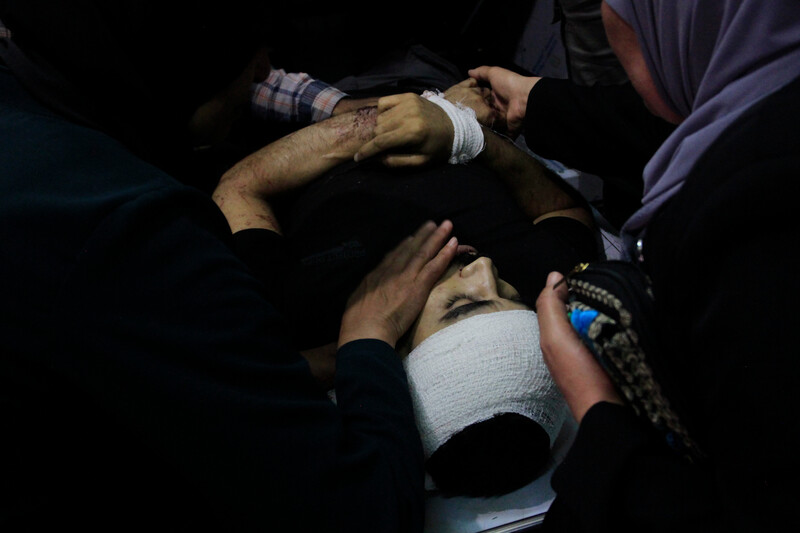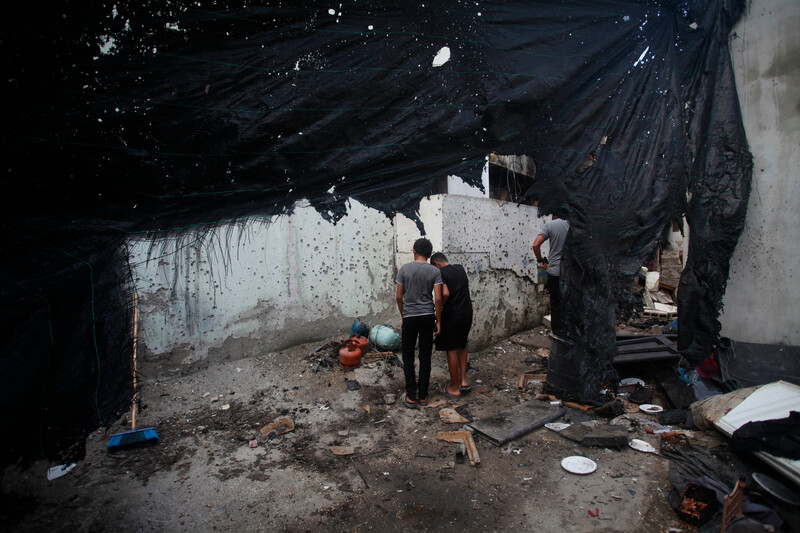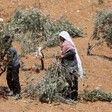Rights and Accountability 31 August 2024

Palestinians grieve for loved ones killed by Israeli forces during a raid near the city of Jenin in the northern occupied West Bank on 28 August.
APA imagesA deadly wide-scale Israeli military assault in the northern West Bank entered its third day on Friday, the largest such attack since the second intifada.
Occupation forces have sealed off cities and refugee camps and inflicted widespread devastation to infrastructure, roads, water networks and have cut off power.
More than 20 years after the Israeli invasion of Jenin and its refugee camp, Israel early on Wednesday launched a “vicious, major military attack” in the governorates of Jenin, Tulkarem and Tubas, Palestinian human rights groups reported.
Israeli forces have killed at least 20 Palestinians as of this writing, including at least five children.
Under the direction of Shin Bet, Israel’s domestic spying and torture agency, hundreds of Israeli soldiers, snipers, Border Police and undercover forces invaded towns and refugee camps with military vehicles, bulldozers, drones and helicopters.
The targeted communities include Jenin refugee camp, Nur Shams refugee camp east of Tulkarem, and the al-Faraa refugee camp in the foothills of the Jordan Valley.
Israeli troops appeared to withdraw from Tulkarem on Friday but escalated attacks on Jenin and its camp, where water and electricity are still cut off. Israeli forces also besieged the main hospital in the camp, firing at paramedics and journalists and killing civilians.
Israeli forces assassinated Wisam Khazem, a Jenin-area commander in Hamas. Israeli troops shot at his car as two fighters from other factions escaped.
The invaders withdrew from the area before bombing it from the air, killing the two fighters and withholding all three bodies. They were named as Myassara al-Masharqa and Arafat al-Amer.
Local media shared footage of the burning car.
Israeli forces shot and killed 82-year-old Tawfiq Ahmad Qandil in Jenin, and then opened fire on the ambulance that came to aid him. Local media shared his picture:Raiding homes and besieging hospitals
“Movement in Jenin and its refugee camp has come to a complete halt, with intense surveillance aircraft hovering overhead,” Palestinian human rights groups reported on Wednesday.
Israeli forces raided and took over homes, interrogated residents and positioned snipers on the roofs of buildings, according to Defense for Children International-Palestine.
“Israeli forces besieged several hospitals in Jenin and impeded the movement of ambulances and paramedics,” DCIP said. They are also stopping and searching ambulances carrying injured, killed or ill Palestinians, human rights groups said.
Israeli forces also threatened to raid the Jenin public hospital – the largest in the area – the director of the hospital Dr. Wisam Baker said.
The hospital’s water supply ran dry on Thursday, medical director Mustafa Hamarsheh said, requiring an emergency replenishment by first responders.
Israeli forces fired at a Palestine Red Crescent ambulance in Jenin on Friday, injuring a doctor and two paramedics. Soldiers also fired live ammunition at journalists covering the assault.
Aerial attacks on children, resistance
Around midnight on Wednesday, an Israeli drone-fired missile hit 13-year-old Murad Masoud Naaja, and his 17-year-old brother Muhammad Masoud Naaja, “killing them immediately and causing their bodies to be torn apart,” DCIP reported.
The boys were on the roof of their home with an older brother, who was critically injured in the attack. Their father was lightly injured as he stood at the front door of the house.
Israeli forces blocked ambulance crews from reaching the bodies of the children, which lay on the roof until the following morning.
“Israeli forces continue showing contempt for Palestinian children’s lives as they carry out aerial attacks in densely populated civilian areas,” said Ayed Abu Eqtaish, accountability program director at DCIP.
Earlier in the week, Israel killed three Palestinian boys in two separate attacks.
Adnan Aysar Jaber, 15, and Muhammad Ahmad Elian, 13, were struck by an Israeli drone-fired missile around 10 pm on 26 August in Nur Shams refugee camp as they stood “near a group of wanted men,” according to DCIP.
A day earlier, Israeli forces shot and killed Mosab Hassan Moqasqas, 17, near the entrance to Marda village, north of Salfit. He had been riding in a car with a Palestinian man, when Israeli forces started shooting at the vehicle. Israeli authorities are withholding his body.
The Israeli military has been carrying out airstrikes in the West Bank regularly since 7 October, reviving a tactic it had rarely used since the second intifada two decades ago.
Almost 50 Israeli airstrikes in the West Bank have killed more than 130 Palestinians and injured more than 40 between October and late August, according to UN monitoring group OCHA.
Notably, all but one of those killings occurred in the West Bank’s northern governorates where the ongoing Israeli assault is taking place.
“In comparison, between 2020 and October 2023, six Palestinians were killed in airstrikes, all in 2023,” OCHA said.
Israel has killed 13 Palestinian children in the West Bank using drones, and another four with US-made Apache helicopters. Israel used a warplane to kill one other Palestinian child.
Killing resistance leaders
Israeli airstrikes have also had an impact on the armed resistance in the West Bank.
“The revival of the airstrikes is significant because ground operations give the leadership and the fighters the opportunity to react to the ground invasion, to defend themselves, to move into positions that they are familiar with, and that gives them a defensive capability,” according to Jon Elmer, contributing editor at The Electronic Intifada.
“The airstrikes are like lightning bolts out of the sky. There’s no way to defend against them,” Elmer added.
During the ongoing assault, Israeli forces have assassinated several resistance militants, including Muhammad Jaber, the leader of the Tulkarem Brigade, which is associated with the military wing of the Islamic Jihad resistance group.
Known as Abu Shujaa, Jaber became a legend when he appeared among mourners in Nur Shams refugee camp in April following an assault in which Israel claimed it had killed him.
Pictures circulating on social media showed an armed Jaber being borne on the shoulders of a crowd of Palestinians.

Palestinians stand near the site of an Israeli drone strike in Nur Shams refugee camp near Tulkarem, in the occupied West Bank on 27 August.
APA imagesIsrael’s killing of experienced resistance leaders in the West Bank is a setback for the military organizations there, but new leaders continually emerge.
“If you kill the leadership, you’re taking the strongest people within the movement, and you’re removing them from the movement,” Elmer said. The Israelis do that by jailing and assassinating local leaders.
“And of course, it has an impact,” Elmer added. But this “doesn’t change the trajectory of these organizations,” he said, noting that the groups Israel fought during the second intifada are the same ones it is facing today.
Gaza tactics
There is growing fear among Palestinians that Israel wants to extend its campaign of mass killing, mass destruction of infrastructure and forcible displacement of the population in Gaza to the West Bank as well.
Palestinian human rights groups warn of the “employment of tactics that mirror those used in Israel’s genocidal campaign in Gaza.”
Israel’s targeting of hospitals and health care facilities in the West Bank is one indication of that. So is the escalating use of airstrikes.
Israel may take the lack of international intervention to stop its near-total destruction of Gaza’s health facilities as a greenlight to escalate such violence in the West Bank.
In recent days, Israeli foreign minister Israel Katz explicitly called for the army to use Gaza-style tactics there.
“We must address this threat with the same determination used against terror infrastructures in Gaza,” Katz wrote on X, formerly known as Twitter.
“Including temporary evacuation of Palestinian residents and any necessary measures.”
Settler leaders are amplifying this call.
Yisrael Gantz, the head of a regional council governing dozens of Jewish-only settlements and outposts in the occupied West Bank, warned of a repeat of 7 October coming from the occupied West Bank – a pretext for the settlers’ longstanding goal of ethnically cleansing Palestinians.
“If we don’t do to Nur Shams what we did in Nuseirat [refugee camp in Gaza], then God forbid they will do to Bat Hefer [a village in central Israel] what they did to Be’eri,” Gantz said, referring to one of the kibbutzes near Gaza that was the scene of bloodshed on 7 October.
Israel’s assault comes amid a surge in attacks on Palestinian villages by Jewish settlers in recent weeks, killing residents and destroying property, with the support of occupation forces.
Surge in killings
Israeli occupation forces and settlers have killed nearly 640 Palestinians in the West Bank since 7 October and injured thousands more, a surge that has been overshadowed by the scale of the slaughter in Gaza.
Over 150 were children.
This is “the highest number of fatalities over a period of eight months since the UN first started recording casualties in the West Bank two decades ago,” UN Human Rights spokesperson Ravina Shamdasani said.
Israeli settlers killed at least 11 Palestinians, and another seven were killed either by the army or settlers.
Settlement expansion is the compass
“Israel’s military attack on northern West Bank governorates should be regarded in light of Israeli intentions to permanently remove Palestinians and (re)establish Israeli colonial settlements instead,” Palestinian human rights groups said this week.
Settlement expansion is a top priority for Israeli Prime Minister Benjamin Netanyahu and his key allies: finance minister Bezalel Smotrich and national security minister Itamar Ben-Gvir.
Both Israeli officials have been aggressively promoting settlement in recent months as attention has been focused on Gaza.
This includes pseudo-legal maneuvers to expand existing settlements and formalize “outposts” – new colonies erected by settlers ostensibly in violation of Israeli regulations.
The West Bank, or “Judea and Samaria” – as Israel has attempted to rename it in order to give a veneer of historical and religious legitimacy to its illegal occupation – is central to the Zionist settler-colonial project.
In 1948, Zionist forces took over 78 percent of historic Palestine and established the Israeli state on it. The West Bank, 20 percent of historic Palestine, remained in Jordanian hands, while Gaza, about two percent of the territory, remained under Egyptian control.
In June 1967, Israel launched a surprise attack on Egypt, and conquered the West Bank, Gaza, Egypt’s Sinai Peninsula and Syria’s Golan Heights. Since then, Israel has withdrawn only from Sinai.
It began colonizing all these territories soon after the occupation began.
In the West Bank, including East Jerusalem, Israel has nearly tripled the number Jewish-only settlements since the signing of the Oslo accords in 1993.
In July, Israel quietly announced one of the largest state land grabs since the Oslo accords.
There are now 700,000 Jewish settlers in the occupied West Bank – all of whom are there illegally under international law.
While Israel withdrew its settlers from Gaza in 2005 – their presence was unsustainable due to the fierce resistance – Israeli leaders are now speaking of reestablishing colonies there.
But the main focus of colonial land theft has always been the West Bank.
Settlement expansion, ethnic cleansing and settler violence in the West Bank has also always been the impetus for armed resistance across historic Palestine.
The May 2021 war on Gaza started with a warning from the Qassam Brigades – the armed wing of Hamas – over Israeli encroachments on the al-Aqsa mosque compound in Jerusalem and plans of ethnic cleansing in the Sheikh Jarrah neighborhood in East Jerusalem.
Human rights groups
António Guterres, the UN secretary-general, called for “an immediate cessation” of Israel’s military attack, according to his spokesperson.
“Only an end to the occupation and a return to a meaningful political process that will establish a two-state solution will bring an end to the violence,” the spokesperson added.
Ritual calls for a two-state solution are a tactic meant to kick the can down the road, politically speaking, while Israel ethnically cleanses Palestinians and steals their land, creating facts on the ground.
Such calls are never accompanied by international action to bring any such “solution” about – notwithstanding its declining support among Palestinians.
“No matter how many they kill, no matter how many they arrest,” The Electronic Intifada’s Elmer said, the resistance ultimately recreates itself.
Despite 11 months of sharply increased Israeli killings, arrests and raids on refugee camps, “the resistance in the West Bank is stronger today than it was on 7 October.”




